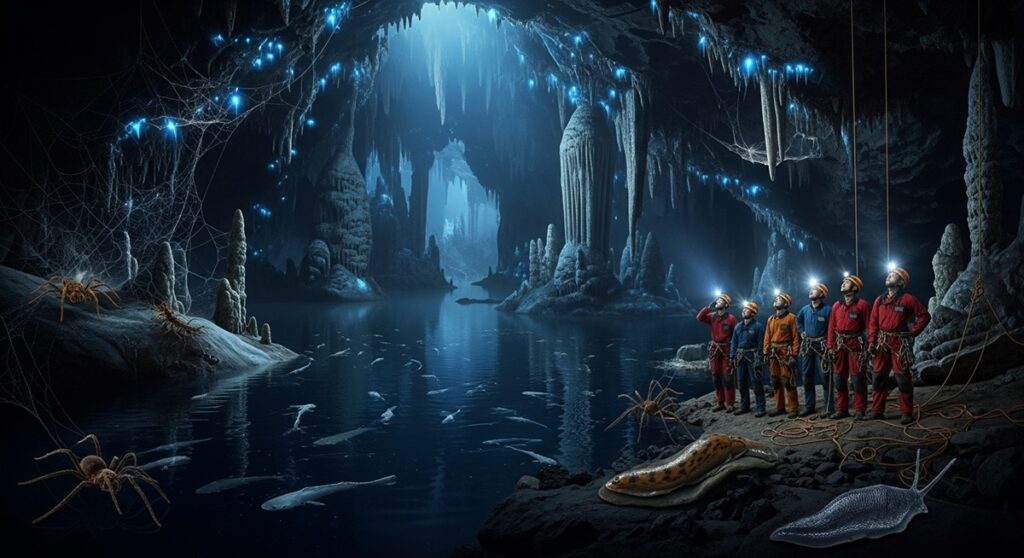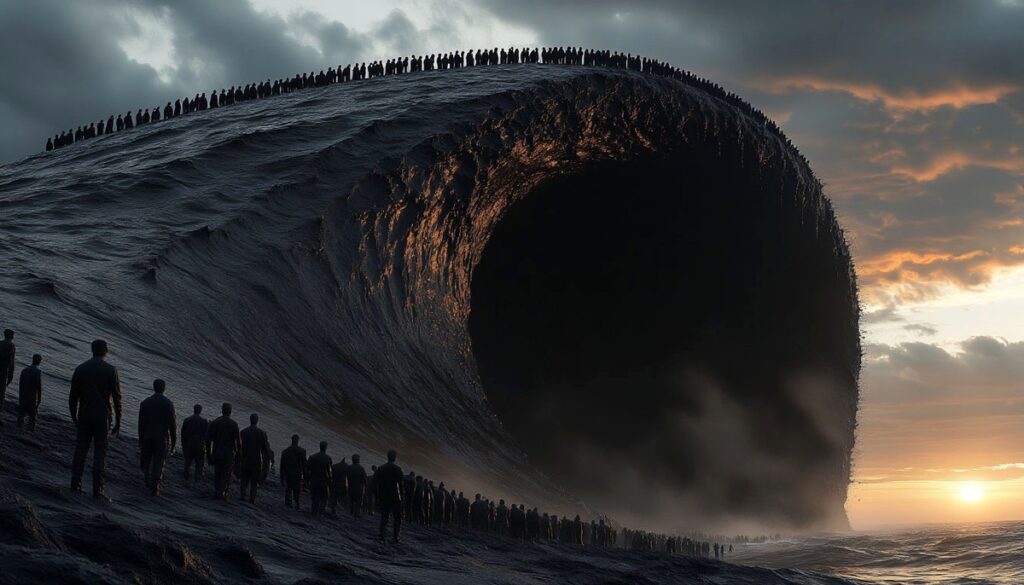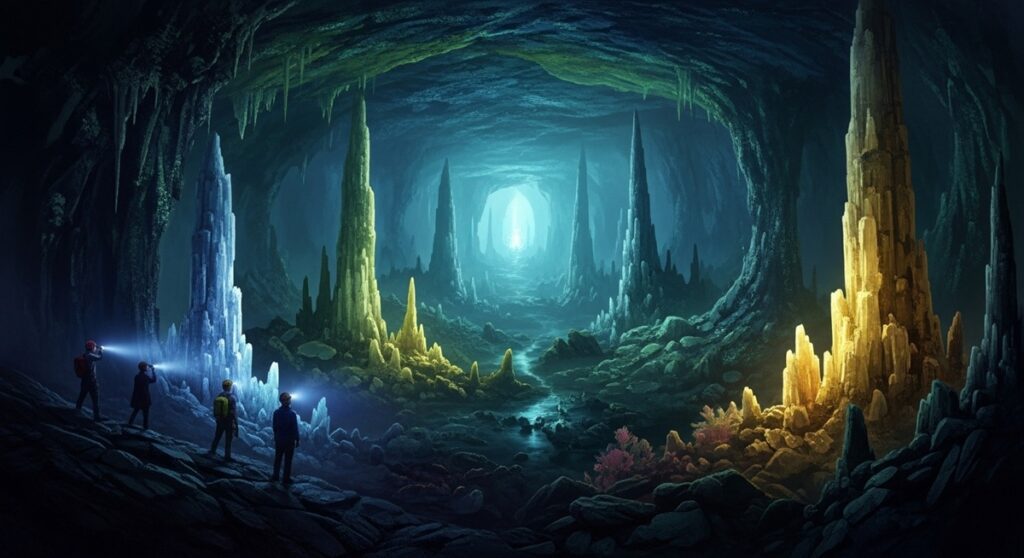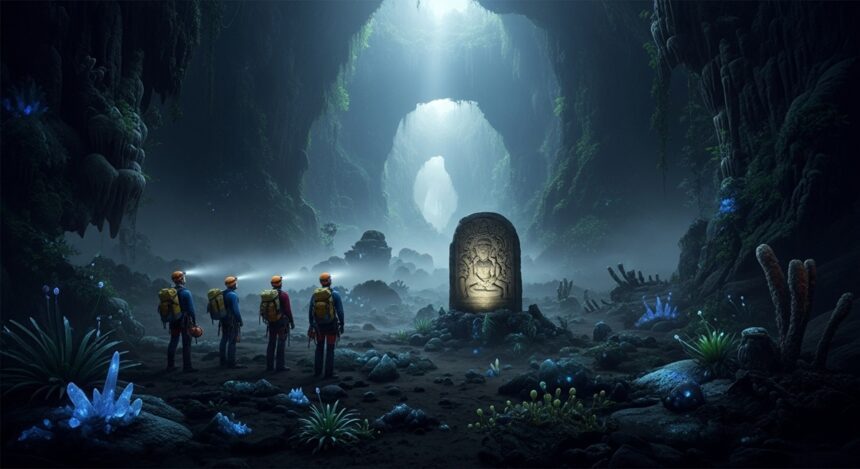In the dense jungles of Cambodia, where ancient temples whisper secrets of lost civilizations, a discovery in 2011 shook the foundations of what we thought we knew about our planet. Hidden beneath the earth’s surface, a vast network of caves remained sealed for millennia, untouched by human hands or the light of day. This was was a portal to an alien world right here on Earth, teeming with bizarre life forms and, according to some, a harbinger of doom. But who are the enigmatic “lunar earthlings,” and what chilling message did their leader deliver in the wake of this find?
This story begins with a group of intrepid speleologists—cave explorers—who ventured into the unknown, armed with cutting-edge technology. What they uncovered was a ecosystem frozen in time, challenging our understanding of evolution and sparking a religious fervor that vibrates across Cambodia today.
The Discovery That Rewrote Underground Exploration
Cambodia’s landscape is riddled with karst formations, limestone wonders sculpted by eons of water and time. But this particular cave, located in a remote region whose exact coordinates remain classified, was different. Detected in 2011 through ground-penetrating radar and seismic surveys, the site revealed massive subterranean voids just inches from the surface in some spots. No natural entrances were visible, suggesting the cave had been hermetically sealed for thousands, if not millions, of years.
Imagine the excitement: a pristine environment, isolated from the surface world. Evolution here would have taken its own twisted path, free from predators, pollutants, or interbreeding with aboveground species. Speleologists, drawn by the promise of groundbreaking discoveries, finally breached the cave in subsequent years. Their initial expeditions, conducted with meticulous care, involved drilling narrow access points and descending via ropes and harnesses.
What they found inside was nothing short of astonishing. The cave system sprawled for kilometers, with labyrinthine passages branching into vast chambers and deep shafts. Underground lakes shimmered in the beam of headlamps, home to blind fish measuring up to 50 centimeters—creatures adapted to perpetual darkness, their eyes reduced to vestigial nubs. These piscine oddities navigated by enhanced lateral lines, sensing vibrations in the water like living sonar systems.
But the biodiversity didn’t stop there. Giant spiders with leg spans rivaling dinner plates wove intricate webs across stalactites, their venom potent enough to paralyze prey twice their size. Centipedes, elongated and armored like prehistoric relics, scurried along damp walls, while luminescent fungi cast an eerie glow, illuminating patches of algae that formed the base of this subterranean food chain. Slugs the size of human forearms left trails of iridescent slime, and worms burrowed through nutrient-rich sediments, recycling organic matter in a closed-loop ecosystem.
Researchers marveled at how these species had diverged so radically. Surface-dwelling relatives bore little resemblance; here, adaptations for extreme conditions—low oxygen, constant humidity, and nutrient scarcity—had forged entirely new evolutionary branches. One biologist on the team likened it to “stepping onto another planet,” where life had improvised solutions to challenges we can barely fathom.
Yet, the thrill of discovery soon gave way to unease. The cave’s air felt thick, almost oppressive, and whispers of something more sinister began to circulate. After three expeditions, the Cambodian government abruptly halted all further exploration. The official reason? Safety concerns. But rumors swirled about hallucinations, visions of catastrophe, and a connection to ancient prophecies. Could this sealed world hold more than just biological wonders?
Visions from the Depths: Hallucinations or Harbingers?
During their final descent, the speleologists encountered something inexplicable. As they ventured deeper, a wave of numbness washed over them, limbs growing heavy, movements restricted to mere twitches of fingers and eyes. It was as if an invisible force had seized control, paralyzing their bodies while leaving their minds acutely aware.
In this frozen state, vivid hallucinations unfolded before them. A shadowy figure materialized, composed of a viscous, black liquid that ebbed and flowed like living ink. It morphed into harrowing scenes: explosions ripping through crowds, people fragmenting into shards; a majestic tree shedding all its leaves in an instant, symbolizing perhaps the death of life itself; towering skyscrapers engulfed by colossal waves, cities vanishing under the sea.
The visions escalated. Rotating spheres, planets, maybe? Shattered like fragile bubbles, one after another, evoking cosmic destruction. But the final image haunted them most: a human form dissolving into a puddle, desperately clawing at glass fragments as if trying to reassemble a shattered self. The figure screamed in silent agony before merging completely into the ooze, leaving only a smooth, featureless surface.

All explorers reported identical experiences, down to the smallest details. Was this a collective delusion induced by toxic gases seeping from the earth’s crust? Methane, carbon dioxide, or even hallucinogenic compounds from the fungi could explain it, after all, no air quality tests were conducted in the rush of discovery. In confined spaces, such gases can accumulate, triggering vivid, shared hallucinations, a phenomenon documented in other cave incidents worldwide.
Yet, the synchronicity raised eyebrows. In interviews leaked to the press, the speleologists described a sense of intentionality, as if the visions were a deliberate warning.
“It felt like something was communicating,” one explorer recounted. “Not just random images, but a narrative of impending doom.”
These accounts spread like wildfire, capturing the imagination of a nation steeped in spirituality and folklore.
Cambodia, with its rich tapestry of Buddhism, Hinduism, and indigenous animism, is no stranger to mystical interpretations. Temples like Angkor Wat stand as testaments to a culture where the divine intersects with the earthly. But this event tapped into something deeper, a fear of the unknown lurking below. Enter the lunar earthlings, a enigmatic group whose doctrines suddenly seemed eerily relevant.
Who Are the Lunar Earthlings? Unpacking a Millennia-Old Mission
The lunar earthlings aren’t your typical religious sect. Emerging from Cambodia’s diverse spiritual landscape, they claim origins far beyond our world. According to their lore, passed down through oral traditions and sacred texts, their ancestors arrived on Earth thousands of years ago from the moon—hence the name. Not literal moon-dwellers, perhaps, but beings tasked with a cosmic guardianship.
At the heart of their belief is a terrifying entity: a “black essence” imprisoned deep underground. This creature, they say, is a primordial evil that fragmented into billions of particles, capable of infiltrating every living being through the air. If unleashed, it would herald the apocalypse, crumbling civilizations and extinguishing life as we know it.

The lunar earthlings’ mission? To contain this beast through rituals, prayers, and spells. Destruction isn’t an option— the entity has fused with Earth’s core essence. Killing it would unravel the planet itself, turning it to “sand of time.” Instead, they maintain a vigilant watch, generation after generation. Currently on their 174th lineage, they anticipate another 826 before cosmic energies purify the world, replacing the creature’s corrupt soul with benevolent light.
This isn’t fringe folklore; the group holds sway in Cambodian society, influencing even high-level officials. In a country where cults and spiritual movements blend with politics, think of the Khmer Rouge’s ideological fervor or modern Buddhist revivals, the lunar earthlings command respect. Their temples, scattered in rural enclaves, host round-the-clock ceremonies, drawing devotees who chant incantations to reinforce the entity’s bonds.
How does this tie to the cave? The visions, they argue, are omens, the black liquid figure mirroring their descriptions of the imprisoned evil. The paralyzed states? A psychic outreach, a desperate signal that the seal is weakening. Cambodian authorities, swayed by these interpretations, urged citizens to join the lunar earthlings’ rites, transforming a scientific expedition into a national spiritual crusade.
The Leader’s Urgent Call: A Message for Humanity
At the forefront stands the movement’s abbot, a revered figure whose words carry the weight of prophecy. In a rare public address following the cave incident, he declared:
“This is no coincidence. The visions are the first omen, a cry from the depths. We must act swiftly, without delay for a second sign. Our duty is to sacrifice our lives in prayer to hold back this ancient horror. I seek no gold, no glory, only your voices raised in unity. Fail, and the sun will vanish from our skies forever.”
His message sparked a surge in memberships. Rituals intensified: candlelit vigils, meditative chants echoing through the night, symbolic offerings of moonstones to reinforce the lunar connection. Skeptics dismiss it as mass hysteria, but believers point to historical parallels, ancient Khmer myths of underworld demons, global legends like the Greek Tartarus or Aztec Xibalba, where subterranean evils threaten the surface.

Could there be truth here? Science offers alternatives: plate tectonics shifting, releasing gases that mimic mystical experiences. Yet, in an era of climate crises and existential threats, the lunar earthlings’ warnings feel prescient. What if their “creature” symbolizes something real—environmental collapse, perhaps, or unchecked human greed eroding the planet’s stability?
Myths, Science, and the Human Psyche
This Cambodian saga isn’t isolated. Around the world, underground discoveries often blur lines between fact and folklore. Think of Mexico’s Cave of Crystals, with its towering selenite formations, or Vietnam’s Son Doong, the world’s largest cave, hiding ecosystems akin to lost worlds. In each, explorers report awe mixed with dread, as if tapping into humanity’s primal fear of the dark.
Psychologically, caves represent the subconscious, Freud would have a field day. Visions like those in Cambodia could stem from sensory deprivation, amplified by group dynamics. But dismissing them outright ignores cultural contexts where spirituality provides coping mechanisms for the inexplicable.
Moreover, the lunar earthlings highlight how religion adapts to modern discoveries. In a globalized world, their moon-origin story echoes ancient astronaut theories, blending sci-fi with spirituality. As climate change unearths more hidden realms, melting permafrost revealing ancient viruses, for instance—their apocalypse narrative gains traction.

Should we heed their call? Pragmatically, no harm in mindfulness or community rituals; they foster unity in turbulent times. Scientifically, reopening the cave for study could debunk myths, analyzing air samples and mapping the network. Yet, with government bans in place, the mystery continues, a tantalizing “what if” for adventurers and thinkers alike.
In the end, whether gas-induced dreams or divine portents, this tale reminds us: beneath our feet lies a world as vast and unknowable as the stars above. Perhaps the real omen is our need to listen—to nature, to each other, and to the whispers of the earth.

















